Arm Announces Mobile Armv9 CPU Microarchitectures: Cortex-X2, Cortex-A710 & Cortex-A510
by Andrei Frumusanu on May 25, 2021 9:00 AM EST- Posted in
- SoCs
- CPUs
- Arm
- Smartphones
- Mobile
- Cortex
- ARMv9
- Cortex-X2
- Cortex-A710
- Cortex-A510
A new CI-700 Coherent Interconnect & NI-700 NoC For SoCs
Finally, the last new announcement of the day is a new interconnect and network-on-chip generation. The last time Arm had announced a mobile/client interconnect was back in in 2015 with the CCI-550. The reason for the large gap between IPs, in Arm’s own words, is that ever since Arm’s introduction of the DSU in its CPU complexes, there really hasn’t been any need for a cache coherent interconnect in the market. While that’s eyebrow-raising from a GPU perspective, it makes perfect sense from a CPU perspective, as coherency between CPU cores was the primary driver for such interconnects until then.
With the advent of new more complex computing platforms, such as NPUs, accelerators, and hopeful more use of GPUs in cache-coherent fashions, Arm saw a need gap in its portfolio and decided to update its client-side interconnect IP.
The new CI-700 is a mobile and client optimised variant of Arm’s infrastructure CMN mesh network, implementing important new interoperability with the new IP announced today, such as the new DSU or CPU cores.
The new mesh interconnect scales up from 1 to 8 DSU clusters, and supports up to 8 memory controllers, and also introduces innovations such as a system level cache.
The mesh network topology and building blocks is very similar to what we’ve seen in the CMN infrastructure IP, in that “points” in the mesh are comprised of “cross-points” or “XP”. One differentiation that’s unique to the client mesh implementation is that XPs can have more attached connectivity ports, trading in routing connection paths. The new IP can also be configured as just a sole XP with no real mesh so to speak of, or essentially a 1x1 mesh configuration. This can grow up to a 4x3 mesh in the largest possible configuration.
The mesh supports from 1 to 8 SLC slices, with up to 4MB per slice for a total of 32MB, and snoop filter SRAM with coverage of up to 8MB address space per slice. It’s noted that generally Arm recommends 1.5-2x of coverage of the underlying private cache hierarchies of the mesh clients.
The SLC can server as both a bandwidth amplifier as well as reducing external memory/DRAM transactions, reducing system power reduction.
We see a reiteration of the support for MTE, allowing for this generation of IPs to support the feature across the new CPU IP, the DSU, and the new cache coherent interconnect.
Alongside the new CI-700 coherent interconnect, we’re also seeing a new NI-700 network-on-chip for non-coherent data transfers between a SoC’s various IP blocks. The big new improvements here is the introduction of packetization for data transfers, which leads to a reduction of wires and thus improves area efficiency of the NoC on the SoC.
Overall, the new system IP announced today is very interesting, but the one question that’s one has to ask oneself is exactly who these net interconnects are meant for. Over the last few years, we’ve seen essentially every major mobile vendor roll out their own in-house cache-coherent interconnect IP, such as Samsung’s SCI or MediaTek’s MCSI, and other times we don’t see vendors talk about their in-house interconnects at all (Qualcomm). Due to almost everybody having their own IP, I’m not sure what the likelihood would be that any of the big players would jump back to Arm’s own solutions – if somebody were to adopt it, it would rather be amongst the smaller name vendors and newcomers to the market. From a business and IP portfolio perspective, the new designs make a lot of sense and allows to have the building blocks to create a mostly Arm-only SoC, which is an important item to have on the menu for Arm’s more diverse customer base.


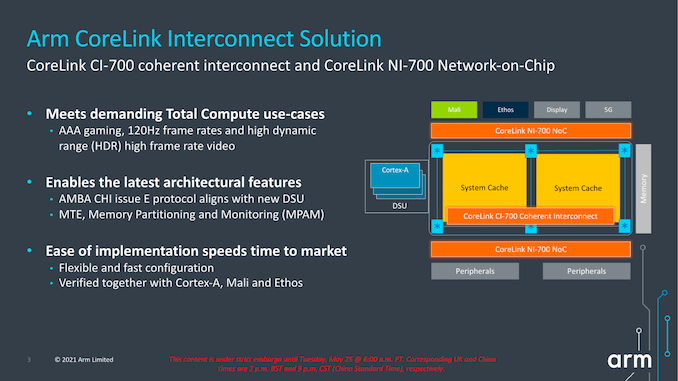

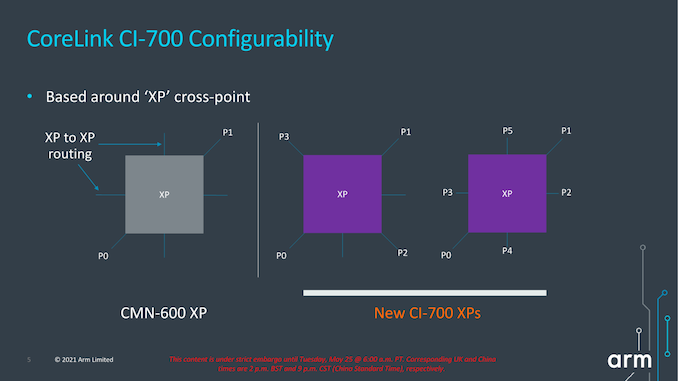
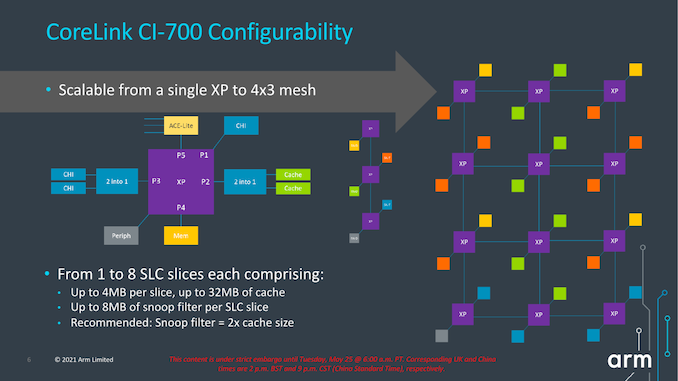
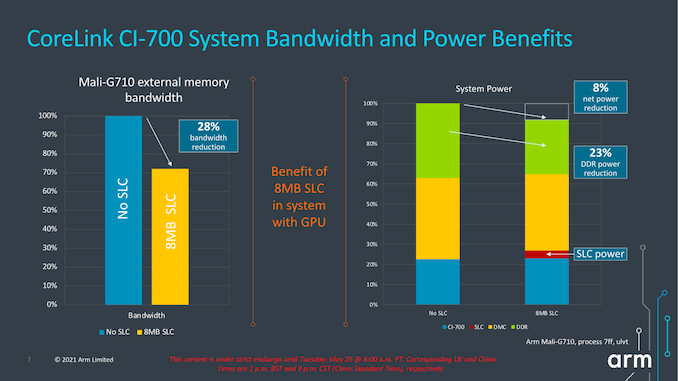
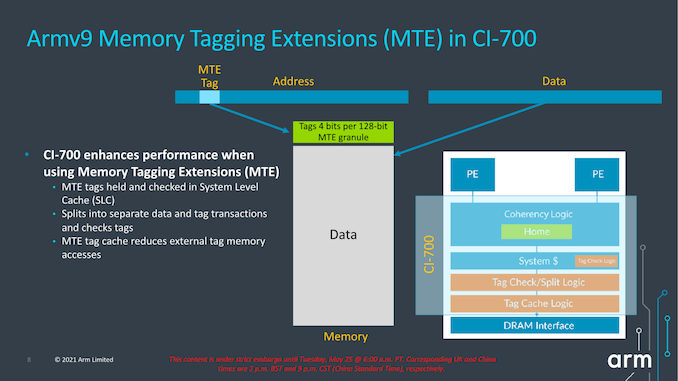









181 Comments
View All Comments
Spunjji - Thursday, May 27, 2021 - link
Comments saying "x86 is dead" are just as daft as the comments declaring that ARM will never be a threat to x86.mode_13h - Tuesday, May 25, 2021 - link
What a terrible naming scheme!If they didn't want to just start from a blank slate, they should've gone on to letters. So, A7A and A5A.
Also, given that the X-cores are typically going to be paired with their cousin A-series core, the naming scheme should reflect that relationship. So, maybe the X1 should've been the X78 and the X2 could be the X710 or X7A.
mode_13h - Tuesday, May 25, 2021 - link
Also, why skip 9? A59 and A79 would be a great mnemonic for the first mobile cores to be ARMv9!nandnandnand - Tuesday, May 25, 2021 - link
I'm fine with the naming scheme.For the Cortex-X line, they can just do X1, X2, X3, X4... X-cetera.
For these new ones, A710 and A510 are the baseline, and they can put out A720, A525, or whatever until they run it up to A799. That could take over a decade if they don't increment the numbers so much. The '7' and '5' let you know these are related to the A78/A55, and the 3 digits lets you know it's part of the brave new world of ARMv9.
mode_13h - Tuesday, May 25, 2021 - link
> they can put out A720That could potentially create some confusion about the relationship between A72 and A720.
> 3 digits lets you know it's part of the brave new world of ARMv9.
Okay, so create a new numbering scheme! No need to piggy back off the old one, if it's "a brave new world", right?
phoenix_rizzen - Tuesday, May 25, 2021 - link
Would have been a good time to pick new letters. Leave Cortex-A, Cortex-X, Cortex-M etc for Armv8.x.Even better, drop the Cortex name, and pick something new for Armv9-based cores.
X, Y, Z would have been nice for big, middle, little cores.
Ah well, marketing-droids will do what marketing-droids do. :D
mode_13h - Tuesday, May 25, 2021 - link
Also, A79 would line up nicely with being the last generation of this microarchitecture family.Then, maybe the "Sophia" cores could start a new numbering series.
GeoffreyA - Thursday, May 27, 2021 - link
"What a terrible naming scheme!"They should battle it out with Intel's Marketing arm to see who's the best in the field of naming.
eastcoast_pete - Tuesday, May 25, 2021 - link
Disappointed in the design choice of the new LITTLE cores. I have the strong suspicion that the IPC comparison of the 510 LITTLE core to the A73 (the 510 getting close to the A73) is with one 510 core per complex, maximal cache and cache bandwidth etc, which, of course, is highly theoretical. After all, the 510s are designed to come in pairs sharing resources for a reason. I am underwhelmed by this design, ARM's own power/perf curves show very little if any difference to A55 until one gets to the high end of the power curve, at which point the 710 big cores would have taken over. Unfortunately, Apple's power/perf crown for efficiency cores remains quite and comfortably safe. As an Android user, however, I remain stuck with ARM's designs, as none of the design houses (QC, Samsung) is even attempting custom core designs for smartphone SoCs. We are seeing the downside of a monopoly heremode_13h - Tuesday, May 25, 2021 - link
> I remain stuck with ARM's designs, as none of the design houses (QC, Samsung)> is even attempting custom core designs for smartphone SoCs.
Qualcomm is saying they're using their Nuvia acquisition to make new mobile cores.